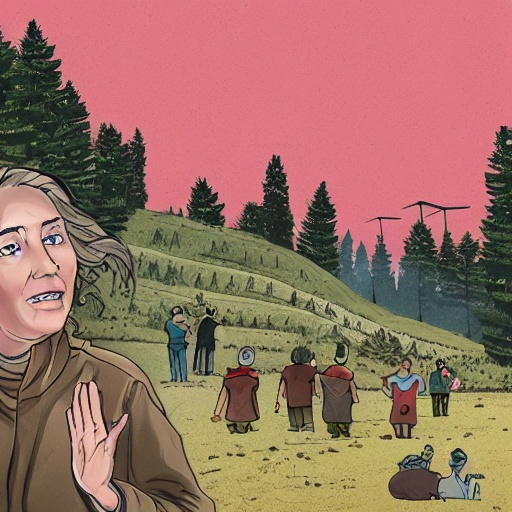
How does ‘A Good Place’ explore the conflicting nature of technology and progress?
In ‘A Good Place’, the conflicting nature of technology and progress is explored through the juxtaposition of images and nature. While technology represents advancement and modernity, nature serves as a counterpoint, highlighting the beauty and simplicity that is often overshadowed by excessive technological development. The film portrays the human obsession with progress and the negative consequences it can have on the environment and society. This is evident in the forest fire that foreshadows the dystopian tone of the film, symbolizing the destructive power of technology. Additionally, the use of eerie radio broadcasts and the impending rocket launch reflect the dangers of unchecked technological advancement. The film raises important questions about the need for balance between technology and nature to ensure a sustainable and harmonious future.
What does the discovery of the curse jar reveal about ancient magical practices?
The discovery of the curse jar in Athens reveals fascinating insights into ancient magical practices. The jar, filled with dismembered chicken bones and inscribed names, serves as evidence of an ancient curse aimed at paralyzing and killing multiple individuals. This discovery sheds light on the belief in and use of curses for control and revenge in ancient times. The use of dismembered chicken parts, particularly the twisted off heads and pierced lower legs, indicates the intended incapacitation of the curse’s victims. Furthermore, the presence of nails, commonly used in ancient curses, suggests the binding nature of the curse. The curse jar’s connection to a possible workplace dispute and political strife in Athens adds a layer of intrigue and historical context. Overall, the discovery of the curse jar provides a glimpse into the ancient world’s practices of magic and the complex beliefs and rituals surrounding curses.
In what ways do the film and the curse jar intersect in terms of symbolism and storytelling?
The film ‘A Good Place’ and the curse jar intersect in terms of symbolism and storytelling. Both the film and the curse jar incorporate dismembered chicken parts as symbols of imminent danger and impending doom. In the film, the dismembered chicken parts appear as a terrible omen, representing the destructive consequences of technology and progress. The curse jar, on the other hand, utilizes dismembered chicken bones to incapacitate its victims, symbolizing the power and control associated with ancient curses. The intertwined symbolism of dismembered chicken parts in both the film and the curse jar creates a sense of unease and anticipation throughout the narrative. Furthermore, both the film and the curse jar tell captivating stories that engage the audience on multiple levels. ‘A Good Place’ challenges conventional narratives and invites reflection on the consequences of our choices, while the curse jar discovery offers a glimpse into ancient magical practices and the use of curses for control and revenge. Together, these elements create a thought-provoking narrative that explores themes of technology, progress, and the enduring human fascination with the mysterious and the unknown.
Full summary
Katharina Huber's film, 'A Good Place', won the best emerging director award and best performance in the Swiss fest's Filmmakers of the Present. The film is an elusive audiovisual journey set in a remote village.
A forest fire foreshadows the dystopian tone of the film. Margarita and Güte navigate daily life and acts of sabotage in the face of an unknown menace. Mysterious disappearances and a sickness sweep through the village, while dismembered chicken parts appear as a terrible omen. Eerie radio broadcasts provide updates on an approaching rocket launch.
Huber's exploration of the conflicting nature of technology and progress is a central theme in the film. It reflects on the human stubbornness to obsess over advancement. Images and nature serve as counterparts to technology, providing contrasting elements throughout the film. Still moments and scenic landscapes create the rhythm of the film.
'A Good Place' is Huber's debut feature, showcasing her craftsmanship in independent filmmaking. It immerses the audience in a long reach and exciting journey that challenges conventional narratives.
In a fascinating twist, an archaeological discovery in Athens sheds new light on ancient magical practices. The agora of Athens revealed an intriguing find - a curse jar dating back 2,300 years.
This jar, filled with dismembered chicken bones, was likely part of an ancient curse that aimed to paralyze and kill 55 people in ancient Athens. The jar contained the dismembered head and lower limbs of a young chicken, with a large iron nail gouged through the vessel.
Inscribed names on the jar, some of which are still visible, suggest its use as a potent binding curse. Nails were commonly used in ancient curses to immobilize the curse's victims. The twisted off heads and pierced lower legs of the chicken indicate the incapacitation intended for the victims.
The curse jar may have been placed near burned pyres to enhance its power. Its discovery suggests an impending lawsuit involving numerous opponents, possibly related to the political strife in Athens at the time. It is speculated that craftspeople in the building may have created the curse due to a workplace dispute.
These two seemingly unrelated events - the film 'A Good Place' and the curse jar discovery - share a common thread of dismembered chicken parts serving as symbols of impending doom. While Huber's film explores the dystopian consequences of technology and progress, the curse jar provides insight into ancient magical practices and the use of curses for control and revenge.
Together, they create a captivating and thought-provoking narrative that engages the audience on multiple levels. 'A Good Place' and the curse jar discovery challenge our perceptions of reality and invite us to question the impact of our actions and choices.
As Huber's film captivates audiences with its mesmerizing visuals and atmospheric storytelling, the curse jar discovery adds an intriguing layer of historical context, reminding us of the enduring human fascination with the mysterious and the unknown.
In conclusion, 'A Good Place' and the curse jar discovery intersect in the realm of symbolism and storytelling. Both offer unique perspectives on the human experience, exploring themes of technology, progress, and the consequences of our choices. Katharina Huber's film and the ancient curse jar provide a fascinating juxtaposition of modern and ancient narratives, leaving us with a profound sense of wonder and reflection.







